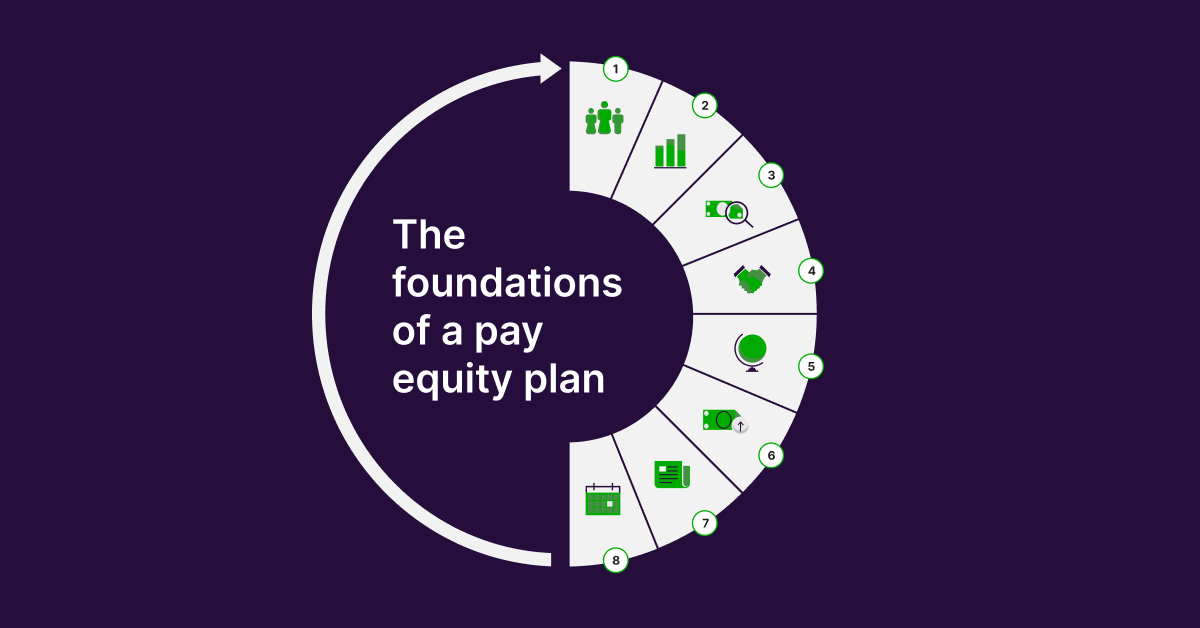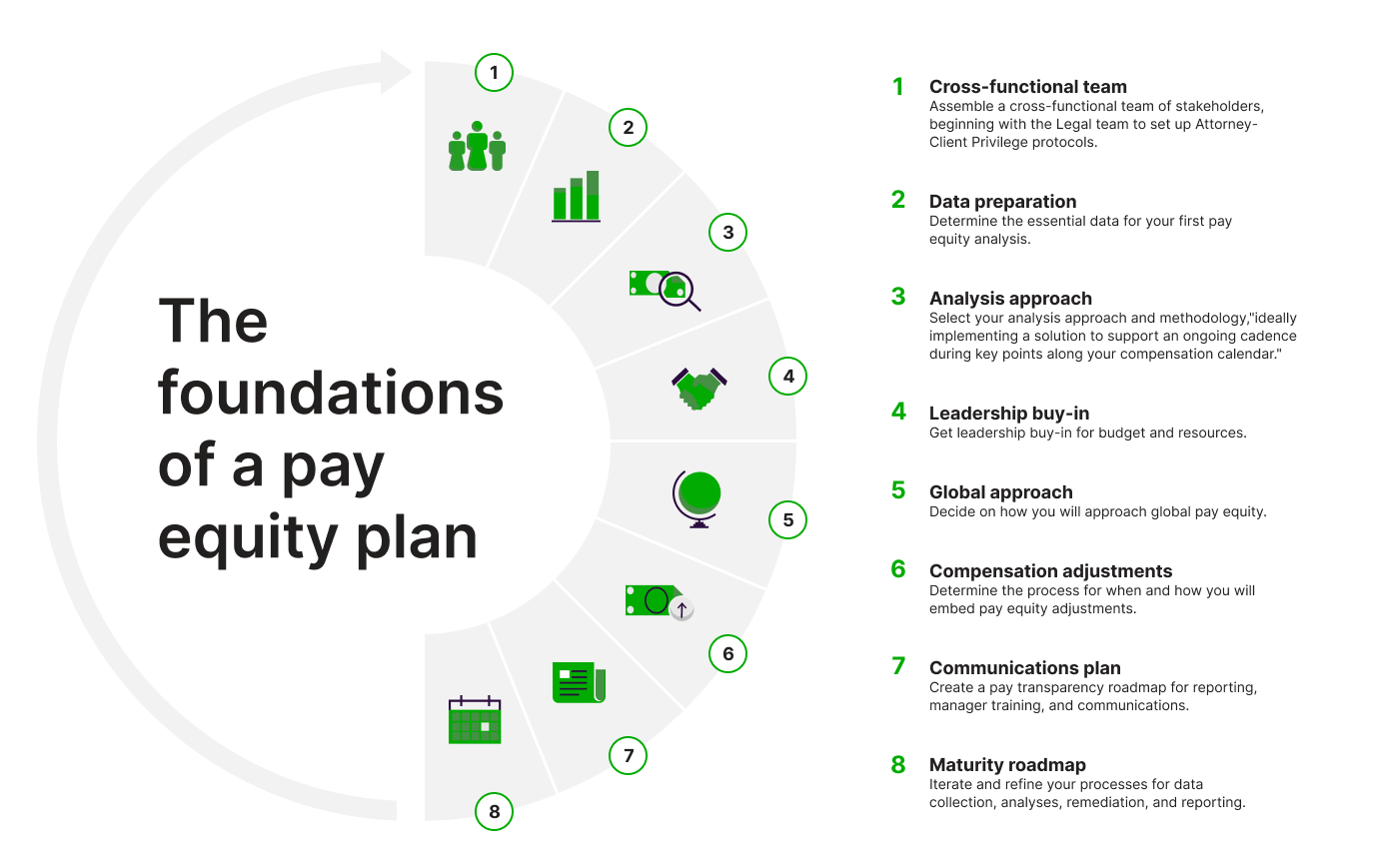As Total Rewards teams gear up for budget season and annual compensation review cycles, they are challenged with how to plan for pay equity, including:
- Training managers how to explain the fairness of pay decisions in light of pay transparency
- Coaching leaders on how to respond to investors and regulators about the company’s commitment to pay equity
- Reporting to boards about their process and methodology to ensure pay equity. Continuing changes in pay transparency legislation only adds to the sense of urgency that the time for addressing pay equity concerns head-on is now.
It’s natural to have a range of questions: How will you navigate the data? Who should be involved? How will you ensure buy-in from leadership? How do you protect privilege? With so many moving pieces, it’s crucial to develop a solid pay equity plan to guide your strategy and key decisions going forward.
Below we walk through the main areas of concern you’ll need to address as part of a pay equity plan and the critical components to get you started on the path to pay equity.
Building a comprehensive pay equity plan
The journey towards 100% pay parity requires careful planning on multiple fronts, from data collection and analysis to leadership buy-in and communications.
1. Assembling a cross-functional team
Building a cross-functional team is instrumental in driving pay equity initiatives forward. In the past, pay equity was primarily viewed as the domain of the legal team for the purposes of mitigating risk. The risks have only increased, however, and they go beyond legal risk. Risk to employer brand is paramount in this tight labor market as companies compete to attract, retain, and engage employees. Leading companies know they need to bring together multiple disciplines and perspectives to solve pay equity in this era of increasing pay transparency. As a result, more Total Rewards teams are leading the work in collaboration with Legal, Talent Management, DEI, People Analytics, and HR Business PartnersBy bringing stakeholders from all of these areas into a centralized conversation, you can align on priorities and goals, achieve consensus, streamline efforts, and coordinate communications. Learn who to include on your workplace equity committee.
Your pay equity plan requires careful consideration of legal and privacy concerns with your legal team. Ensure that whichever pay equity solution you choose has validated legal compliance with features for preserving attorney-client privilege. Ask the provider how they would handle discovery requests and whether their methodology is compliant with EEOC and DFEH expectations and methods. Ask if they can help you conduct privileged pay analysis for each establishment — and prove it to the OFCCP without waiving privilege. Learn how Syndio helps you conduct a privileged pay analysis
2. Prepping the data: What you need and what you don’t
The starting point of any successful pay equity plan lies in the data — and the concern of “We don’t have complete or accurate data” is a common roadblock to getting started. Don’t let perfect be the enemy of good: even the limited data you have and the insights gained from an analysis will greatly inform and enhance subsequent data collection and analyses. Remember, creating a successful pay equity program is not a one-time audit: it is an ongoing process with iterative improvements made each time you run an analysis.
There are of course certain foundational pieces of information you need to start, including employee identifiers, compensation data that can be translated into meaningful “apples to apples” rates, and sufficient coverage of identity variables (meaning you have enough employees on each side of the variable of interest, such as gender, to run a statistical analysis).
The more data you have, the more robust your results will be, but if you don’t have perfect job groupings or job architecture, missing internal or external control data, or performance ratings, you can still run a baseline pay equity analysis. The key thing is to not let missing, messy, or decentralized data hold you back from starting. And Syndio’s team of experts can help guide you through the process so that, even with limited data, you can still conduct a meaningful analysis and determine how to improve your methodology and data collection going forward. Read The Data You Do — and Don’t — Need for Your First Pay Equity Analysis to dive deeper.
3. Choosing your analysis approach and solution
Deciding how to execute your pay equity plan is a critical step. Do you enlist external expertise through consulting or utilize specialized software? What methodology will you use for the analysis? How often will you run analyses and report on results? There are pros and cons to any approach and, of course, the decision is highly dependent on your organization’s unique needs, budget, and available resources.
Consulting vs. software? (Hint: it doesn’t have to be either/or!)
The traditional annual, outsourced pay equity audit is simply too slow to keep up with current transparency demands. In contrast, always-on pay equity software can adjust and rebalance the model as employees enter and exit, helping you keep your finger on the pulse of pay equity as your organization flexes and evolves. Additionally, to proactively prevent issues from reappearing (rather than retroactively “fixing” them again and again), software analytics can help flag pay practices and policies that may be causing pay inequities. Through automation, pay equity analysis software can improve efficiency by enabling companies to devote fewer resources and less time overall to analyses, as well as reducing remediation costs over time by helping to identify and address root causes of inequities.
However, using a self-serve software solution with little to no ongoing support or support that’s billed by the hour is also problematic. Pay equity is too important, risky and complex to be using software without the benefit of consulting. Expert guidance is needed to ensure you are approaching pay equity within legal parameters, in consideration of the latest legislative trends, incorporating the best statistical methods as well as in consideration of your overall compensation strategy.
The best balance is purpose-built pay equity software combined with ongoing access to thought leadership and expert guidance in leading analysis methodologies, compliance, compensation management and communications. With Syndio, you don’t have to choose between expertise and software — you get both.
→ Want to see how Syndio’s pay equity software stacks up to traditional approaches, such as law firms and consultants? Compare side-by-side
Selecting pay equity software
Not all pay equity software is created equal — most solutions can tell you what pay disparities you have and who they impact, but fail to identify why those disparities are happening in the first place.
Learn how to cut through the marketing jargon to pinpoint the must-haves and the deal breakers with our comprehensive Pay Equity Software Buyer’s Guide. It covers key features, critical questions, an RFP template, and the evaluation checklist you need to get pay equity right the first time.
→ Get the Pay Equity Tech Buyer’s Guide
Methodology
There are various ways to approach a pay equity analysis and it’s important to find the most appropriate and optimal method for your specific use case. Proven, expert-driven approaches around groupings, controls, remediation, root cause analysis, and other features strengthen the analysis. Thoroughly vet any consultant or software provider to understand the reasons and advantages behind their chosen methodology. Explore 3 primary methodologies in When It Comes to Pay Equity, Methods Matter.
4. Garnering buy-in from leadership
Building a successful pay equity program requires careful change management — and securing buy-in from leadership around pay equity is a crucial step in any pay equity plan. To gain commitments from the top, it’s important to bring a compelling, data-driven narrative to the table — why does this matter? Be clear on the benefits, the risk of inaction, and the ask. Demonstrate the business case of pay equity via the risk of litigation, brand catastrophe, and employee turnover.
Link your message back to your audience’s priorities, whether that’s the lens of risk mitigation, improved efficiency through digital transformation, the desire to keep up with peers or be on the leading edge for your industry, or the impact on the bottom line. Keep the story “high and tight” by being selective around using high impact “bullseye” data points that connect the dots to why the company will be at a competitive disadvantage if you don’t take action. Plan ahead for common objections. Finally, progress takes time so set expectations that results won’t be immediate and clearly lay out what the time frame to see ROI will be.
5. Addressing global complexity: The benefits of a unified approach
For organizations spanning multiple countries, ensuring pay equity on a global scale is a unique challenge — especially with the passage of the EU Directive for Equal Pay and Transparency. Some of the common requirements in jurisdictions with pay reporting obligations include providing data on salary difference between male and female employees, regular review of pay gap policies, publishing pay gap data (either publicly or directly to government authorities), and penalties for noncompliance which can include fines or other disciplinary action.
Global companies must factor in their approach to complying with this maze of regulations as part of their pay equity plan. As more jurisdictions add pay reporting requirements, the scale is tipping in favor of taking a unified global approach to pay equity rather than a “patchwork” compliance approach that is specific to each unique jurisdiction. A global approach allows for a more simplified, consistent, and coordinated process.
Syndio’s Global Pay Reports is a one-stop solution to streamline statutory pay gap reporting and ensure compliance with local laws and regulations in 48 jurisdictions in Europe, the U.S., and around the globe. You can also preview EU Directive Reporting. Request reports with a single click and get the analytics you need to submit your reports, with step-by-step guidance, communications advice, and more. Learn how to streamline your global pay gap reporting.
6. Taking action on pay equity adjustments.
Most companies build the analysis steps in their pay equity plan to align with annual compensation planning so they can make changes during the annual cycle. It’s important to outline that process and how you will embed pay equity adjustments. Using software is particularly useful in this case, as it provides the speed and flexibility for you to analyze proposed compensation changes inclusive of merit increases so you are confident you are not creating unintended inequities.
If pay equity adjustments are scheduled for other times, you will have to be prepared to explain the adjustments. Some companies choose to be more transparent with managers and employees about the nature of adjustments. Your level of transparency depends on your company’s culture and typically requires a comprehensive communications plan, including messages from leaders, manager training, and FAQs.
Preserving pay equity should also be built into your overall plan. Using technology that brings together your market-informed salary ranges with your internal pay equity analysis for every pay decision outside of your compensation cycle is a great way to ensure that you don’t “undo” pay equity as you hire new employees or promote current ones.
7. Crafting a plan for stakeholder communications
It’s no longer optional to keep pay behind closed doors — employee salary ranges are out in the open on job boards and on crowdsourcing sites. But while embracing pay transparency is an integral part of the journey towards pay equity, but it can also be intimidating. Building pay explainability into your compensation program is becoming crucial so that employees understand why they’re paid what they’re paid. Manager training is an important component of this to equip managers to skillfully answer questions about pay with the employees who report to them.
Employees also want to know they’re paid fairly. Part of your pay equity plan must include a communications roadmap. Work with your leadership team and Communications team to determine how much you want to share about your pay equity results. It may be that initially you will only report to leadership and the board, but as you get more comfortable with the pay equity process and see progress, you may plan to eventually share results with employees or even with the public in ESG and/or DEI reports. You may even eventually consider pursuing third-party validation such as Fair Pay Workplace Certification to enhance your employer brand.
8. Iterating and refining your processes to mature your pay equity program: Deeper analyses and a more proactive posture
Pay equity is an ongoing journey — achieving pay parity doesn’t happen overnight and it has to be constantly analyzed and maintained to avoid sliding back into inequities. It’s also a constant learning process. Bake in a feedback loop in which each analysis can be used to enhance your pay equity program going forward. Build in retrospective sessions after each analysis to determine where you can improve or expand your data collection, data clean-up, job architecture, analyses, remediation, and reporting and communication. Where should you dig deeper? What additional data or analyses should you add? When additional reporting might you add in the future?
A strong pay equity plan will look ahead for how you plan to mature your program. If you start by only analyzing gender, build a plan for when you will start analyzing race/ethnicity and the intersection of gender and race/ethnicity. Are there other relevant categories you will eventually want to start analyzing, such as LGBTQ+ status, veteran status, and/or caregiver status?
It’s also important to plan to become more proactive over time so you can start preventing inequities before they start. When might you want to begin analyzing starting pay? What tools can you use to dig into pay policies to uncover root causes of inequities? By maturing your program to become preventive rather than reactive, you can potentially reduce remediation costs over time, improve compliance with global regulations, and become more comfortable sharing results with employees and other stakeholders in the pay transparency era.
You don’t have to do it all alone! Talk to the Syndio team to learn how we can help your organization progress on your pay equity journey.
The information provided herein does not, and is not intended to, constitute legal advice. All information, content, and materials are provided for general informational purposes only. The links to third-party or government websites are offered for the convenience of the reader; Syndio is not responsible for the contents on linked pages.




